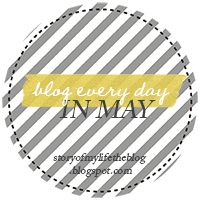Day 2 - Educate Us on Something You Know Alot About or Are Good At
Originally I had added this in with yesterday's topic and it had been about banana bread. This morning while I was waking up my toddler and getting her dressed for the day I realized there was something that I was knowledgeable about that could use some talking about.
Cloth diapers.
These aren't your grandma's cloth diapers and rubber pants. That is a common misconception I've run into since I began cloth diapering my youngest daughter when she was a few months old.

I always hear how cute my daughter's diaper cover is, but when I say that it's not a cover, it's her actual diaper. I get the what's, the no way's. Then the "tell me more". It can be very overwhelming though. There are so many different styles and brands and places to buy. It was only many months into cloth diapering that I began to feel I had a grasp of what I was doing.
Here is a general break down of what you might hear when asking about cloth diapers:
All in One or AIO - A cloth diaper that has a waterproof cover and an absorbent inner liner all in one piece. All In Ones are frequently used by parents who need a convenient diaper for a day care, for quick and easy changes on the go, and by parents who just want the convenience of a one-piece diaper along with the ecological advantages of cloth.
All in Two - A mix of pocket diapers and AIO. With an all-in-two, the insert goes directly again the baby's skin and can be changed out without having to wash the cover every time.
Aplix - A hook and loop closure. Such as Velcro.
Nappy - European word for diaper.
Fitted Diaper - A fitted diaper has elastic at the legs and usually, at the waist. Fitted diapers have closures built in such as Aplix or snaps. A fitted diaper requires a cover.
One-Size Cloth Diaper - A one size diaper usually fits a child from birth up until about 30 or 35 pounds. Although I have found that one-size diapers generally fit better once your baby reaches 10+ lbs. Of course, my babies were around 7 lbs at birth. This diapers typically have a row of snaps on the front of the diaper. This allows for the front of the diaper to be folded over and to create a smaller size. As the baby grows, several snap settings allow for waist and leg growth.
Pocket Diapers - A pocket diaper is usually made of an absorbant fleece (or fleecelike) inner layer and a waterproof outerlayer. These two layers sewn together form a pocket for an absorbent insert. These diapers do not require the additional use of a diaper cover.
Flat diapers - Single layer diapers just like granny used to use. Not really good for today's modern diapers, but make great liners or burp cloths.
Prefold diapers - Rectangular shaped diapers that are divided into three sections. The outer sections are thinner with the inner section having more layers for absorbency. These require a waterproof cover and need to be pinned or used with a Snappi.
PUL - Polyurethane laminate. The waterproof fabric.
The majority of my cloth diaper stash are pocket diapers, though I do have several prefolds that I use with a Snappi fastener. There are newborn sized cloth diapers available, but I never purchased or used any. In total I've probably spent around $500 for all of the diapers that I have, but when you compare that to the cost of disposable diapers, it seems to be a no-brainer to me. Not to mention the ecological impact of all those disposable diapers. I will use these same diapers until she is potty trained and then they can be resold! Waste not, want not!
Washing and drying cloth diapers is a bit trial and error. However, when you find the way that works best for you, you'll never look back. I currently use Charlie's Soap to wash my diapers. It is a little pricey, but I only wash diapers every other day so it lasts a while. My method is as follows:
- Warm rinse
- Hot wash
- Cold rinse twice
During the warmer months of the year, I hang my diapers outside on a line to dry. Sunlight is amazing when it comes to removing stains. Also it's a great energy saver! During the Winter, I do use my clothes dryer, but you have to be careful of the temperature as high temperatures can cause covers and the PUL (the waterproof laminate) to de-laminate and that would cause leaks.
Overall I am very please with my decision to use cloth diapers. It is much easier than people realize. There are several blogs and websites that can help you get started.
Dirty Diaper Laundry
Cloth Diaper Resources on Pinterest
Diaper Pin
Ultimate Cloth Diaper Care Resource Page
Diapering Basics
Cloth Diaper Users Guide
I did this video how-to for Sew is Your Baby a while back. It's a brief two minutes of what a pocket diaper is all about.
Overall I am very please with my decision to use cloth diapers. It is much easier than people realize. There are several blogs and websites that can help you get started.
Dirty Diaper Laundry
Cloth Diaper Resources on Pinterest
Diaper Pin
Ultimate Cloth Diaper Care Resource Page
Diapering Basics
Cloth Diaper Users Guide
I did this video how-to for Sew is Your Baby a while back. It's a brief two minutes of what a pocket diaper is all about.







No comments